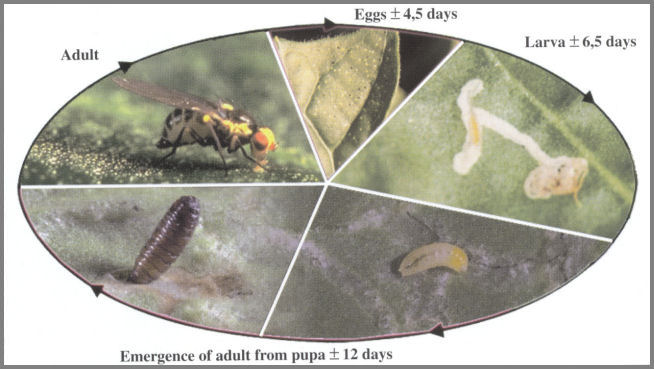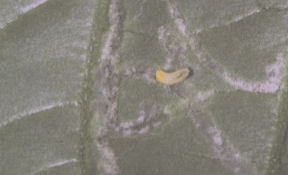Liriomyza Trifolii
The leaf miner, a small fly belonging to the Agromyzedae family, was first introduced into Europe from America, probably through chrysanthemum plantlets towards the mid 70s.
In Italy it’s presence was first noted in 1978. Currently in many countries it represents, together with Thrips parasites that effect the Gerbera.
It is a polyphagous insect, capable of infesting numerous horto-floro plants and weeds. Amongst leaf miners the Liriomyza T. is undoubtedly most troublesome to growers, both because of its voraciousness, and it’s ability to become resistant to insecticides.


The adult leaf miner is a fly of small dimensions (2,0-2,5 mm), it has a yellow head, a blackish thorax, and a clear yellow abdomen with clear brown striped wings. The larva are a yellow orange colour, whilst the pupae are small firm brown-yellow pods about 2 mm, usually visible on the upper leaf surface. The male is smaller than the female, they both usually fly about during the morning, and they mate in the daytime.
The virgin females cannot lay eggs if not fertilized by the male. These, by means of a small thread, pierce the leaf epidermis on the upper side, causing lacerations from which vegetable sap comes out which also acts as nourishment for the adult male unable to pierce the leaves. From the yellow-cream coloured eggs the yellow larva emerges. This feeds by digging a tunnel-serpentine mine- in the leaf mesophyll, narrow in the first few centimetres but becoming wider and wider, ending with a large circle. If you hold the leaf against the light you can see along the whole length of the tunnel a blackish line made by the larva excretions. If the larva is not present in the tunnel, the larva’s exit hole can easily be seen in the shape of a half moon at the point where the tunnel opens into a large circle.
From the larva comes the pupa that very often, in cases of strong infestation, is visible because it rests upright from the point where the leaf has been perforated. The cycle is completed with the transformation of the pupa into an adult.

The duration of the cycle varies according to the temperature, with optimal values, of 27 – 28 C the cycle can be completed from egg to adult in about 14-16 days.
At temperatures higher than 30 C, larval mortality gradually increases. At optimal temperatures, the larval phase is much shorter, lasting from 4 days at 30 C to 7-8 days at about 20 C.
The adult leaf miners live on average 13-30 days, depending on the temperature, the females live longer. The male/female ratio is generally balanced. According to laboratory research the following has been noted: at 13 C the insect does not reproduce, at a constant 14 C the eggs openings block, and only at about 16 C do the adults start merging from the pupa.
Observation made in different greenhouses also show, that in cold environments the insect lives through at least one generation during winter, while in well-heated greenhouses numerous generations follow each other in succession.


Larva Liriomyza Trifolii
Pupa Liriomyza Trifolii
The principal damage is caused by the larvae that dig tunnels in the leaf mesophyll, also considerably reducing the plants’ photosynthesis and thus the growth and production. In cases of stong infestation the leaf miner is also able to lay eggs inside the ligulate flowers.
We must remember, however, that the leaf miners Phytomiza Horticola and Phytomiza Syngenesiae, known to the floriculturists as “”Old miners””, today have been completely supplanted by Liriomyza Trifolii.
The old miners, grey-black coloured, have pale yellow larvae. The pupa are found like the LiriomyzaTrifolii at the end of the broadening tunnel dug in the leaves. However, unlike the LiriomyzaTrifolii, the4 pupae are located inside the leafrather than above it’s surface. This, and the winding tunnel which they produce, distinguishes the old miners from the Liriomyza Trifolii.


Eggs
Leaf miner with larva inside
Return to the top of Leaf miner
